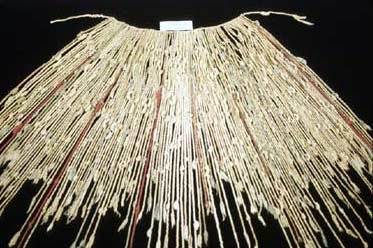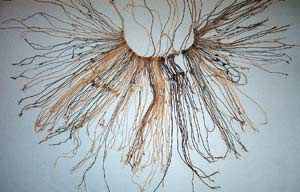Over 500 years before the advent of computers, the Inca people living in the Andes Mountains (Peru) invented a 7-bit binary code to store information, which they represented using knotted cords known as khipu. This discovery challenges the long-held belief that the Inca civilization was the only major bronze-age culture without a written language.
 |
|
Inca Khipu (Source: Sunysb) |
Khipu, in the Quechua language (the official language of the Inca Empire), means “knot”. This decorative item consists of a main cord from which several symmetrical strings branch out (which can be attached in secondary or tertiary strands), adorned with numerous knots or loops. In 1923, historian Leland Locke demonstrated that khipu were not merely decorative items but a form of string-based abacus, where the knots functioned to store calculation results, similar to the wooden beads on a Chinese abacus. However, Locke’s rules only deciphered a small fraction of the 600 khipu discovered in the region.
Since no one has been able to decode these knots, many scholars argue that khipu were essentially random artifacts created by individuals within the Inca community. Some even viewed them as “memory aids,” intended to recount ancient stories or remind their owners to perform certain tasks.
Recently, however, Gary Urton, a professor specializing in pre-Columbian studies at Harvard University (USA), proposed a revolutionary hypothesis in his book “Signs of the Inka Khipu.” He suggested that these knot patterns not only adhered to a unified standard but also represented a high-level writing system, comparable to writing developed by the Sumerians (in Mesopotamia), the Egyptians, the Maya (in Central America), and the Chinese. Although none of these writing systems are as flexible as the alphabet (which can represent an infinite number of syllables), all were significant advancements in human capability during the early stages of civilization, allowing for more effective documentation of the surrounding world compared to primitive pictorial representations.
By analyzing 32 khipu found in 1997 (along with 225 mummies in a cave in northern Peru), Urton and his colleagues discovered that any trained individual could decode the khipu code. On three of these khipu, they noted compatible sequences that could be used to transmit numerical data.
 |
|
Source: Pravda |
“We have the first evidence of a system of control and verification. It is a clear indication that the Inca did not store information in a way that only the creator could understand</em,” Urton stated.
He also suggested that the binary code of khipu could store at least 1,536 data points (compared to the original cuneiform script of the Sumerians, which had 1,300-1,500 characters, or the 600-800 hieroglyphs of the Egyptians and Mayans). This number results from combinations of 7 choices (such as material, twisting direction, knotting direction, color, etc.) during the khipu’s creation. For example, each khipu could be made from either cotton or wool. The weaver had to choose one of these materials when creating their knot sequence. They would also need to decide on the direction of the knotting—clockwise or counterclockwise—and select from 24 colors available for weaving the cords… Altogether, these combinations result in 1,536 ways to “write” a khipu character.
If Urton’s discovery is correct, then the Inca not only chose a binary code—the mathematical foundation for computer operations—at least five centuries before humans actually invented computers, but also left the world with a unique three-dimensional “writing” language known to date (current languages are represented on a flat surface, such as paper or walls…).
Compared to ancient Greek or Roman civilizations, the Inca are only the focal point of a handful of studies, leaving many mysteries surrounding this people yet to be explored. Continuing to decode khipu may help clarify numerous questions about their civilization, such as how they could build perfectly interlocking walls without using binding materials, or what they used to construct the “city in the sky” Machu Picchu.
B.H.


















































